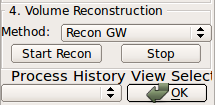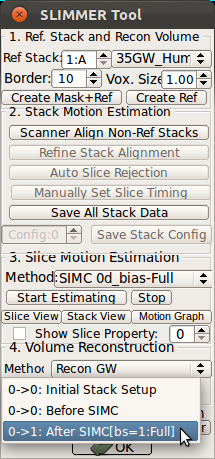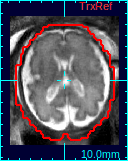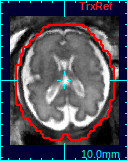SLIMMER
E. Volume Reconstruction
1. Volume reconstruction methods
Currently two reconstruction methods are available: Gradient weighted Gaussian averaging (GWGA, or GW)[2] and Structure tensor averaging of neighbors (STAN, or ST)[3]. In general, STAN generates the final reconstruction with less aliasing artifacts.
2. Running reconstruction
Click Start Recon button to initiate a reconstruction process from the state in Process History View Selection list.*IMPORTANT* Please ensure that the After SIMC state is selected in the Process History View Selection list, unless you intend to reconstruct the volume from a slice configuration before motion correction.

Once Start Recon button is pressed, this button will be disabled until the reconstruction process is completed. The reconstruction typically takes a few minutes. Below are a few records from actual runs on a linux machine with Intel Core i7 (Quad Core with hyperthreading) 2.0GHz CPU,
3. Checking the result
After a 3D volume is reconstructed, a new state will be added to Process History list. Select the new reconstruction state, and the reconstructed volume will appear in the reference panel of RView.You can compare the results with the initial reference volume, or other reconstructions using the Process History list.
 |
 |
 |
| Original ref. | GW recon. | ST recon. |
«Tutorial Main ‹prev next›
![[UW Pediatrics]](/bicg/images/uwp24.jpg)
